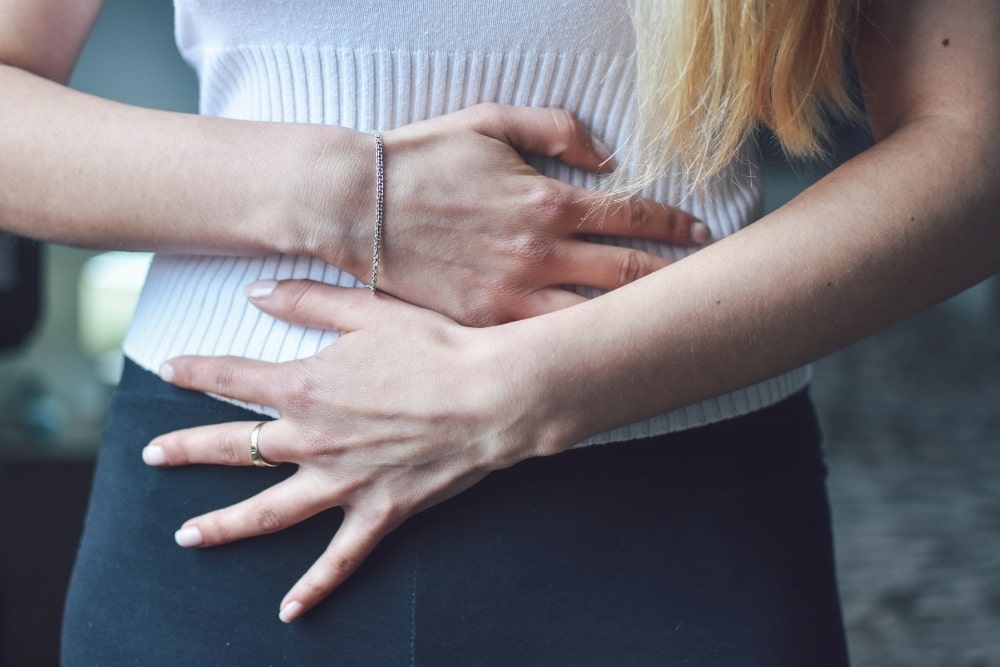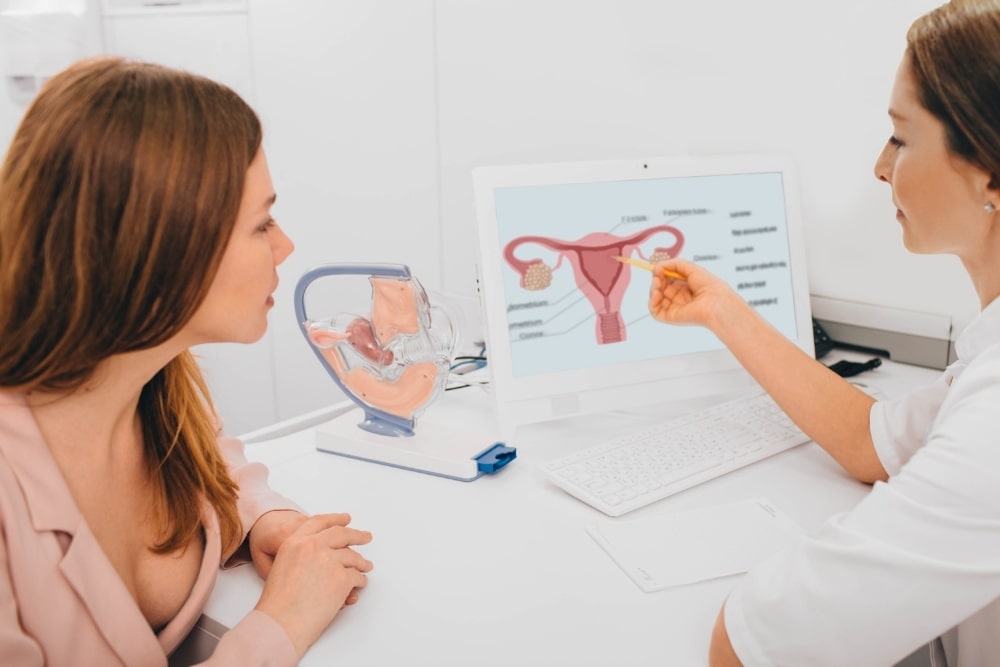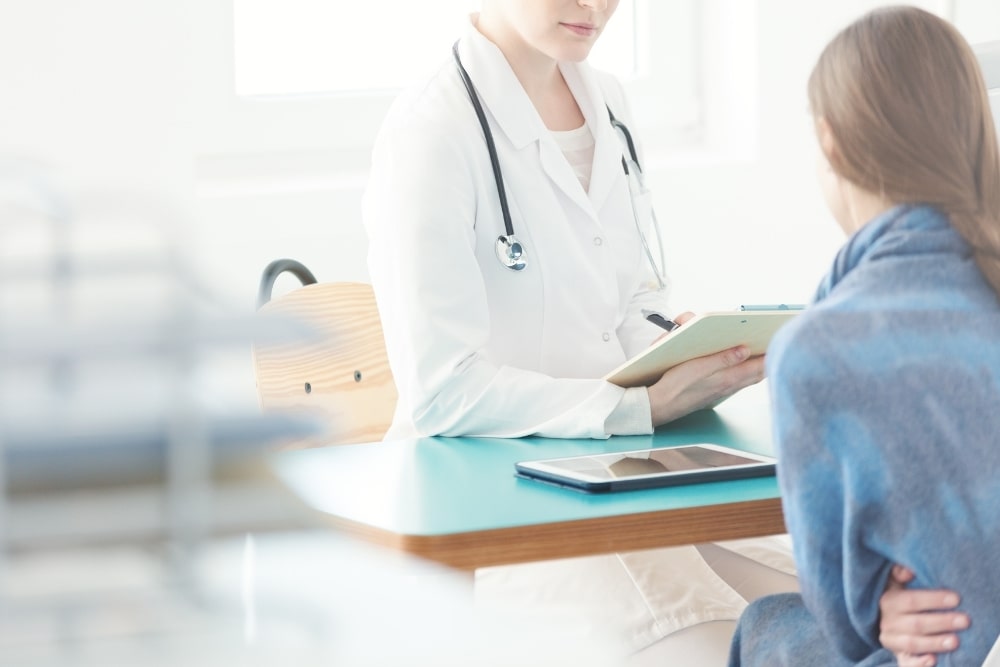If you’re feeling the itch right about now, don’t worry.
Like many women, there are times in our lives when the lady parts feel 100% and then there are other times – when those sensitive areas down below may feel an itch, burn, or even show signs of inflammation.
All of these feelings are undesirable, yet at the same time, they are also a completely normal (even common) part of a women’s livelihood.
The various sensations from good to bad to downright horrible are completely normal to experience sometimes. In other words, yeast infections happen to the best of us.
Or, perhaps you’ve somehow lucked out up until now, and this causes you to wonder if yeast infections and pregnancy are connected…?
Is it possible that yeast infections are more common, or even a definite sign that you’ve become pregnant?
Thankfully, this is a well-discussed topic with tons of research so we can dive right into it based on other women’s experiences and scientific studies.
Yeast infections are caused by a fungal imbalance and PH imbalance
3 out of every 4 women will experience yeast infections at least once in their lifetime.
Some women will develop what is called persistent yeast infections, and along with this will need to set a maintenance plan in place that helps their body maintain a healthy balance of yeast and bacteria within the vaginal canal.
Though it’s not fun, unfortunately, it is just part of being a woman. Ladies aren’t exempt from sweat, unwanted fungus, or bacterial growth.
Even the most cleanly women can have about of yeast infection, unfortunately.
What are the signs of a yeast infection being present?
There are a few telltale signs to look out for when it comes to having a yeast infection. And trust me, most women will know once they have a yeast infection taking root.
Yeast infections are far from fun, and if not resolved with your assistance can become much worse over time.
View in gallery
Some of the following are signs and symptoms of a yeast infection
- Burning in the vaginal canal or outer labia
- More watered down discharge than usual
- The vulva will present swollen and red
- Cottage cheese textured discharge that is thick and not runny and does not contain odor
- Any type of vaginal rash
Beyond a regular yeast infection, there is something called a complicated yeast infection
A complicated yeast infection is basically a yeast infection that is recurrent or more difficult to treat.
You can get a complicated yeast infection if you’re pregnant, have other conditions such as HIV, if you have a weakened immune system, or if the yeast infection you have is caused by an outsider species of fungus.
Is having a yeast infection after ovulation an indication of pregnancy?
Getting a yeast infection after ovulating might be a really good sign of pregnancy. In the sense that, pregnancy throws many of your regular bodily functions out of whack – especially the PH balance in your vaginal canal.
Many women experience their first yeast infections ever in their lifetime during pregnancy. Yeast infections and pregnancy go hand-in-hand.
The changes began directly after the embryo implants in your uterine wall, this is because your body starts pumping out an all-time increase of pregnancy hormones the moment it detects a baby growing.
Progesterone, estrogen, and other pregnancy hormones are meant to cause changes to your body – to assist with growing the baby – but it can also throw off the PH balance of your vagina resulting in a yeast infection.
View in gallery
Estrogen is the main culprit for causing yeast infections early in pregnancy
It’s not uncommon for women to notice the lady parts acting completely abnormal upon falling pregnant.
Estrogen is being produced in copious amounts from the start of pregnancy.
It helps with the production of fetal organs, kickstarting labor at the end of pregnancy, and will become somewhat of a leader in all other hormone regulation.
Even though estrogen has all of the positive roles it plays in pregnancy, sadly it can be annoying at times, think yeast infections and increased morning sickness.
If you find that things are acting suddenly wonky down below, it’s a good idea to take a few pregnancy tests over the course of the next month. Just to ensure that you catch your pregnancy early on if you truly are pregnant.
Your partner can have a yeast infection as well and it’s important to keep an eye out for symptoms before they spread to you
Yeast infections are some of the most uncomfortable problems to treat for women, and they can get really bad – really fast. You might wake up one day feeling mildly itchy and then have sores within a day or two.
Once you feel the following first symptoms of yeast infection it’s important to start home remedies to try and counteract the imbalance.
The first signs of a yeast infection for men are
- Itching or burning on the penis accompanied by redness
- White or shiny spots on the penis
- White thick discharge around the skin folds of the penis
- If your partner is exhibiting any of the following symptoms he may need to be treated by a doctor as well, in order for both of you to move on from this infection. It often happens for couples to pass back and forth yeast infections since the bacteria remains present.
View in gallery
Openly communicate with your partner when you feel that you have a yeast infection to see if they’re experiencing any of the following symptoms as well.
You will want to have your yeast infection checked by a doctor if any of the following occur
At certain times you should absolutely see your primary physician regarding possible yeast infection.
Ladies, please schedule an appointment with their doctor or obstetrician (if pregnant) for a possible yeast infection if the following occur at any point of suspecting you’ve come down with a yeast infection.
If you’re currently pregnant and the yeast infection has not resolved with over the counter remedies
Sometimes yeast infections are a little harder to resolve. So, if you’re finding that it’s not going away on its own then you might want to see your doctor about being prescribed medication to help resolve the infection.
Even if you plan to purchase over-the-counter medications to help resolve your yeast infections, your doctor should approve them if you’re pregnant.
Sometimes yeast infection medications sold in stores can be medicated, and it’s best to be sure that it’s safe for your body prior to use.
Having a baby in your belly is a time where it’s important to seek medical assistance, even when what you’re doing seems obvious or simple – like buying a yeast infection cream.
Don’t be embarrassed to speak with a professional to keep you and your little one safe.
If this is the first yeast infection you’ve ever had in your entire life you’ll want to be seen by a professional
View in gallery
Sometimes it takes one to know one, a professional eye that is – healthcare providers have been trained to spot a true yeast infection. Doctors and gynecologists are equipped with the proper tools to diagnose your yeast infection.
To diagnose a yeast infection your doctor will ask you a series of questions regarding what you’ve been experiencing – don’t worry they’re used to talking with women about these matters.
If anything, going to see your doctor for yeast will do a lot of good, and leave you feeling reassured about what is going on with you.
It’s also important to see your doctor because the symptoms you’re experiencing could be something different than a yeast infection.
Urinary tract infections and other sexually transmitted diseases can closely resemble a yeast infection in certain phases of the disorder.
Having it confirmed that you don’t or do have something outside of just a yeast infection is utterly important, especially during pregnancy.
The sooner that you have confirmed what’s going on with your body – the sooner you can begin treating it properly.
If yeast infections are something you always end up with it’s time to see a doctor
Chronic yeast infections are considered when you have 4 or more yeast infections a year.
After all, that’s a lot of time for your body to be putting in overtime to ward off fungal infections. If you tend to have yeast infections often, it’s time to see your doctor and implement a plan to hopefully reduce them from thriving.
Yeast infections happening on a frequent basis aren’t fun or healthy…you should speak with a professional when it starts to seem like you’ve had too many yeast infections (2-4 a year).
View in gallery
How are yeast infections diagnosed by a doctor?
You might find that seeing a doctor for a yeast infection is particularly uncomfortable.
Many women don’t know what to expect when they schedule an appointment for this matter. It can be embarrassing to speak over the phone about it as well.
You can email the clinic you’re at, and ask what a yeast infection exam entails. But, the most common way for practitioners to diagnose yeast infections is by speculation and lab work.
This means that you will enter your doctor’s office exam room, change into a gown, and they will open your vaginal canal with a speculum to look for swelling or unusual discharge.
While they are examining your vaginal canal, they will take a cotton swab and gather a lab sample.
A lab sample is examined right away in the doctor’s office usually, and you’ll be able to know right away if a yeast infection is present or not.
How are yeast infections generally treated by a doctor?
How you and your doctor treat the yeast infection depends on a variety of factors – such as if you’re allergic to any medications, if you’re currently pregnant, or if you’re having a hard time resolving your yeast infection.
It’s generally a good idea to get on board with a possible prescription or antibiotics from a doctor to resolve a difficult yeast infection.
Usually, a medicated topical cream or an oral medication will do the trick. You can discuss this with your doctor to see what’s best for you. Most women find that one dose of oral antifungal medication is enough to treat most yeast infections.
You might be prescribed a cream for a more intensive treatment if the yeast infection is severe
There might be times when a yeast infection doesn’t respond to over-the-counter treatment plans. When this happens your doctor might need to prescribe you a single dose of antifungal oral or topical medication.
Usually, this type of prescription will wipe out the yeast infection without any problems. If a week of home treatment doesn’t work, you might consider this kind of treatment.
You have to schedule an appointment with a gynecologist or your primary physician if home treatment doesn’t work.
When to see a doctor or gynecologist for a yeast infection
View in gallery
If you have yeast infections frequently or they occur often, it might be time to see a specialist regarding the issues you’ve been having.
Recurring yeast infections can be potentially harmful due to the way your immune system has to focus on fighting off the infection.
It’s not good for your body to constantly or frequently have to fight off yeast infections. See your doctor if you have more than 4 yeast infections in a year.
Some women have reported getting yeast infections every month – not only is that uncomfortable in general – it can be dangerous to have an active infection every month.
If you have a suppressed immune system due to health issues, it’s a good time to see you, physician, at the first sign of a yeast infection.
Setting up a plan with your primary will help eliminate any unnecessary negative factors that could become relevant when treating a yeast infection.
Yeast infections happen for a variety of reasons and to be honest it isn’t certain why they occur
It’s hard to determine why a yeast infection happened because there are so many causes. Scientists have found that a naturally occurring fungus called Candida is the microorganism that causes yeast infections.
Alongside this fungus, there are other imbalances occurring due to the excess Candida like extra yeast growth and thickened discharge which is the prime breeding ground for harmful bacteria.
All humans (women) have naturally occurring yeast in the body at all times. Yeast can overgrow in warm moist areas that sweat.
Sweat and lack of good hygiene is also a prime contributor to yeast infections. If you work out, be sure to rinse off directly after sweating.
Many common thing’s like sex, working out, or wearing the same shorts twice can cause the natural healthy yeast in the vaginal canal to become tipped in the wrong direction.
View in gallery
How long does it take for most yeast infections to resolve?
Most mild yeast infections will resolve within 1-3 days. A yeast infection that is severe, can last up to 3 weeks.
If a yeast infection lasts much longer than 3-weeks or is getting worse by the time 3-weeks come around, you might want to have it looked at by a healthcare professional.
Most yeast infections will respond quickly to home remedies within the first week of symptoms appearing.
Home remedies for a yeast infection might be a great option if you notice symptoms early on
The next best alternative before you choose a course of antibiotics is going through a slew of home remedies to see if the yeast infection reacts in a positive way. Home remedies are easy to incorporate daily once you know how and what to do.
Yeast infections can be combated by numerous things you might already have in your kitchen cupboard. Ingredients like Himalayan salt or oil of oregano are a few of the ways to eliminate a yeast infection right at home.
Oil of oregano is a powerful antimicrobial and antifungal plant medicine that can help eliminate yeast infections
[amalinkspro type=”showcase” asin=”B07G1JRPV9″ apilink=”https://www.amazon.com/dp/B07G1JRPV9?tag=mominformedcom-20&linkCode=osi&th=1&psc=1″ new-window=”true” addtocart=”false” nofollow=”true” sc-id=”4″ imgs=”LargeImage” link-imgs=”false” specs=”Carlyles Oil of Oregano is a convenient way to reap the benefits of this nutritious herb~~~Oregano oil in softgels or as an extract supports and nourishes healthy skin and nails*~~~Carlyle Oregano Oil sofgels contains naturally-occuring Carvacrol~~~Carlyle High Potency 3000mg softgels are easy to swallow and convenient to take” btn-color=”#ff9900″ btn-text=”Check Price” alignment=”aligncenter” hide-prime=”0″ hide-image=”0″ hide-price=”0″ hide-button=”0″ width=”750″]Oregano Oil 3000 mg 150 Softgel Capsules[/amalinkspro]
Because yeast infection is usually a type of overgrowth from fungus oil of oregano can be quite effective in combating it in a state of excess overgrowth.
Oil of oregano comes in capsule or tincture form and can be taken multiple times throughout the day as needed. If the yeast infection seems to be worse, then you can administer more oil of oregano accordingly.
It’s hard to take too much oil of oregano but following the directions on the bottle is best. You can even apply oil of oregano topically to the yeast if you have a carrier oil when applying it.
Topically, the oil of oregano can be quite effective in combating an overgrowth of yeast or thrush. Simply insert an oil of oregano capsule into your vagina at night, or apply it to the skin around the vagina along with a carrier oil.
This powerful oil boosts your immune system while fighting off harmful bacteria – yeast infections can often be caused by a gut flora imbalance – which oil of oregano balances out internally when ingested in capsule or tincture form.
Garlic can eliminate a yeast infection even when it has become severe
Garlic is a powerful plant medicine known to slow the growth of yeast across the body as a whole.
You can insert a clove of garlic into your vagina in the case of a severe yeast infection – to do this you need to place it in a piece of cheesecloth – and be ready to take it back out in just a few minutes.
Upon inserting the clove of garlic there might be slight burning or watering sensations within the vagina; all of which are helpful.
It shows that the garlic is actively fighting off the overgrown yeast. If it becomes too uncomfortable you can remove it as early as necessary.
The great thing about garlic is how effective it is, when baking bread if the garlic is added before the dough has risen it will not rise properly since the yeast in the dough was killed by the garlic.
Another method to using a clove of garlic for yeast infections is to insert the clove of garlic right before bedtime; then upon waking remove the clove of garlic.
It’s a bit easier to do this at bedtime since the vagina might become watery which can be slightly difficult to deal with during the day.
View in gallery
You have the option of continuing this treatment each night until the yeast infection has cleared up, or you can do it for one night and then resume additional treatments at home to boost your immune system.
Epsom salt, Himalayan salt, and baking soda can all draw out a yeast infection
You might find that baking soda, Epsom salt, or Himalayan salt bath can greatly soothe a yeast infection.
These salts and baking soda alike can inhibit the growth of a yeast infection from the first signs and symptoms to later on in the cycle of the yeast infection.
At the first sign of an itch or inflammation, you can soak for 20 minutes in a few dashes, plus 3 cups of Epsom or Himalayan salt. Do this a few times a day for the best results and to soothe any itchy or soreness of the area.
In Conclusion
You might find that you are indeed pregnant after you have a yeast infection, this can happen due to a variety of reasons but probably can be attributed to an imbalance in the PH balance during pregnancy.
Yeast infections are uncomfortable and can cause painful symptoms or some women will have yeast infections with hardly any symptoms. It depends on the severity of the yeast infection, and how long it has been active within the body.
Yeast infections happen to the best of us, and most commonly women will experience their first yeast infection ever during pregnancy.
So it makes sense that a yeast infection could be one of the first signs of pregnancy a woman might experience.
Try to resolve yeast infections with home remedies, and if this doesn’t work or yeast infections seem too severe to treat at home – contact your primary physician or obstetrician right away.
Sources
Common Symptoms of A Yeast Infection – WebMD
Yeast Infections Should You Treat Yourself or A Doctor – WebMD
Can a UTI cause a false negative pregnancy test






